Rafael Viñoly
| Rafael Viñoly Beceiro | |
|---|---|
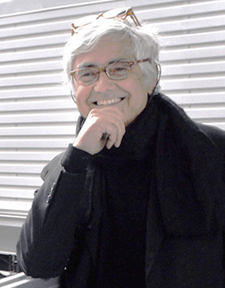 Rafael Viñoly | |
| Born |
1944 Montevideo, Uruguay |
| Alma mater | University of Buenos Aires |
| Occupation | Architect |
| Awards | International Fellow, The Royal Institute of British Architects (2007), Medal of Honor, American Institute of Architects, New York Chapter (1995), National Academician, The National Academy (1994) |
| Practice | Rafael Viñoly Architects PC |
| Buildings |
Brooklyn Children's Museum Tokyo International Forum The Kimmel Center for the Performing Arts David L. Lawrence Convention Center Howard Hughes Medical Institute Janelia Farm Research Campus Bronx County Hall of Justice Carrasco International Airport 432 Park Avenue 20 Fenchurch Street |
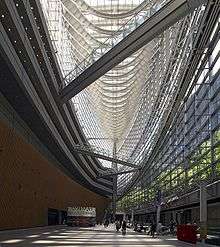
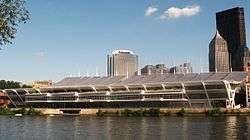
Rafael Viñoly Beceiro (born 1944) is a Uruguayan architect.[1] He is the principal of Rafael Viñoly Architects, which he founded in 1983 and has offices in New York City, Palo Alto, London, Manchester, Abu Dhabi and Buenos Aires.[2]
Life and career
Viñoly was born in Montevideo, Uruguay to Román Viñoly Barreto (a film and theater director) and Maria Beceiro (a mathematics teacher). He attended the University of Buenos Aires, receiving a Diploma in Architecture in 1968 and a Master of Architecture from the School of Architecture and Urbanism in 1969.
In 1964, he formed the "Estudio de Arquitectura Manteola-Petchersky-Sánchez Gómez-Santos-Solsona-Viñoly" architectural firm with six associates. This practice would eventually become one of the largest architectural practices in South America, completing many significant commissions in a very short time.
In 1978, Viñoly and his family relocated to the United States. For a brief period he served as a guest lecturer at the Harvard Graduate School of Design, settling permanently in New York City in 1979. He founded the firm Rafael Viñoly Architects PC in 1983. His first major project in New York was the John Jay College of Criminal Justice, which was completed in 1988. In 1989, he won an international competition to design the Tokyo International Forum. Completed in 1996, many people consider this building to be the most important cultural complex in Japan. His firm's design was one of the finalists in the World Trade Center design competition.[3]
During the course of his forty-plus year career, Viñoly has practiced in the United States, Latin America, Europe, Asia, Africa, and the Middle East.[4]
Viñoly is a Fellow of the American Institute of Architects, an International Fellow of the Royal Institute of British Architects, and a member of the Japan Institute of Architects as well as the Sociedad Central de Arquitectos.[5]
Honors and awards
- Design Honor, Salvadori Center, 2007
- International Fellow, The Royal Institute of British Architects, 2006
- National Design Award Finalist, Cooper-Hewitt National Design Museum, 2004
- Neutra Medal for Professional Excellence: In recognition for his contributions to the Environmental Design Profession and in honor of Modernist architect Richard Neutra, 2000.[6]
- Honorary Doctorate, University of Maryland, 1997
- Medal of Honor, American Institute of Architects, New York City Chapter, 1995
- National Academician, The National Academy, 1994
- Fellow, American Institute of Architects, 1993[7]
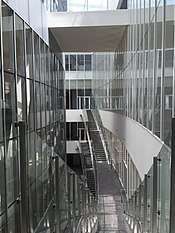 Interior of Campus Center building, New York University Abu Dhabi
Interior of Campus Center building, New York University Abu Dhabi
Buildings
Major works by Viñoly include "Manhattan's Middle Finger" 432 Park Avenue, 20 Fenchurch Street and the Curve Theatre.
Criticism
Carbuncle Cup
The building 20 Fenchurch Street in London won the 2015 Carbuncle Cup for its ugliness.[8]
Sun Glare
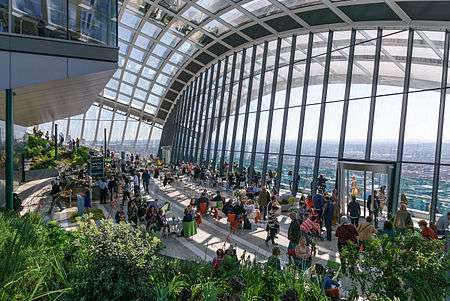
Two of the skyscrapers designed by Viñoly, the Vdara in Las Vegas and 20 Fenchurch Street in London, have experienced unusual sun reflectivity problems due to their concave curved glass exteriors acting as respectively cylindrical and spherical reflectors for sunlight. In 2010, the Las Vegas Review Journal reported that sunlight reflected off the Vdara's south-facing tower could make swimmers in the hotel pool uncomfortably warm, as well as melting plastic cups and shopping bags; employees of the hotel referred to the phenomenon as the "Vdara death ray".[9] In London during the summer of 2013, sunlight reflecting off 20 Fenchurch Street melted parts on a parked automobile as well as scorching the carpet of a nearby barber shop.[10]
References
Notes
- ↑ Gitschier, J. (2011). "The Connection between Space and Thinking: An Interview with Rafael Viñoly". PLoS Genetics. 7 (12): e1002445. doi:10.1371/journal.pgen.1002445. PMC 3248556. PMID 22242010.
- ↑ "Rafael Vinoly Architects Locations". Vinoly Architects. Retrieved 2015-07-03.
- ↑ "Works". Retrieved May 8, 2015.
- ↑ Raphael Vinoly Architects. "Life getting hot for architect Rafael Vinoly". Retrieved May 8, 2015.
- ↑ e-architect (January 8, 2015). "Rafael Vinoly Architect : Practice Information". Retrieved May 8, 2015.
- ↑ "Archived copy". Archived from the original on 2014-10-19. Retrieved 2014-10-12.
- ↑ Rafael Viñoly Architects. "Architonic". Retrieved May 2015. Check date values in:
|accessdate=(help) - ↑ BBC News: London's Walkie Talkie judged UK's worst building
- ↑ "Vdara visitor: 'Death ray' scorched hair".
- ↑ "'Death Ray II'? London Building Reportedly Roasts Cars".
Bibliography
External links
| Wikimedia Commons has media related to Rafael Viñoly. |